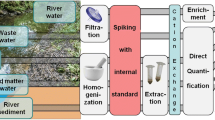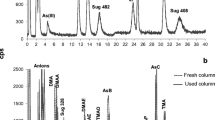Abstract
A new anion-exchange chromatographic separation method was used for the simultaneous speciation analysis of selenoamino acids and the more ubiquitous inorganic selenium oxyanions, selenite and selenate. For quantification, this separation was coupled to inductively coupled plasma-mass spectrometry to achieve an instrumental detection limit of 5 ng Se L−1 for all species. This chromatographic method was also coupled to electrospray tandem mass spectrometry to observe the negative ion mode fragmentation of selenomethionine and one of its oxidation products. Low detection limits were achieved, which were similar to those obtained using inductively coupled plasma-mass spectrometry. An extensive preconcentration and cleanup procedure using cation-exchange solid-phase extraction was developed for the identification and quantification of trace levels of selenomethionine in environmental samples. Preconcentration factors of up to five were observed for selenomethionine, which in addition to the removal of high concentrations of sulphate and chloride from industrial process waters, allowed for an unambiguous analysis that would have been impossible otherwise. Following these methods, selenomethionine was identified at an original concentration of 3.2 ng Se L−1 in samples of effluent collected at a coal-fired power plant’s biological remediation site. It is the first time that this species has been identified in the environment, outside of a biological entity. Additionally, oxidation products of selenomethionine were identified in river water and laboratory algal culture samples. High-resolution mass spectrometry was employed to postulate the chemical structures of these species.

A preconcentration and clean-up procedure using a cation-exchange resin allows trace levels of selenomethionine to be identified in high-ionic-strength environmental samples






Similar content being viewed by others
References
Hamilton SJ (2004) Sci Total Environ 326:1–31
Stewart R, Grosell M, Buchwalter D, Fisher N, Luoma S, Mathews T, Orr P, Wang WX (2010) In: Chapman PM, Adams WJ, Brooks ML, Delos CG, Luoma SN, Maher WA, Ohlendorf HM, Presser TP, Shaw DP (eds) Ecological assessment of selenium in the aquatic environment. CRC Press, Boca Raton
Maher W, Roach A, Doblin M, Fan T, Foster S, Garrett R, Möller G, Oram L, Wallschläger D, Chapman PM, Adams WJ, Brooks ML, Delos CG, Luoma SN, Maher WA, Ohlendorf HM, Presser TP, Shaw DP (2010) Ecological assessment of selenium in the aquatic environment. CRC Press, Boca Raton
Young TF, Finley K, Besser J, Hopkins WD, Jolley D, McNaughton E, Presser TS, Shaw DP, Unrine J (2010) In: Chapman PM, Adams WJ, Brooks ML, Delos CG, Luoma SN, Maher WA, Ohlendorf HM, Presser TP, Shaw DP (eds) Ecological assessment of selenium in the aquatic environment. CRC Press, Boca Raton
Riedel GF, Ferrier DP, Sanders JG (1991) Water Air Soil Pollut 57–58:23–30
Dungan RS, Frankenberger WT Jr (1999) Biorem J 3:171–188
Wu L (2004) Ecotoxicol Environ Saf 57:257–269
Pilon-Smits EAH, Quinn CF (2010) In: Hell R, Mendel R-R (eds) Cell biology of metals and nutrients. Berlin, Springer-Verlag
Gómez-Jacinto V, García-Barrera T, Garbayo I, Vílchez C, Gómez-Ariza JL (2012) Pure Appl Chem 84:169–333
Cutter GA (1978) Anal Chim Acta 98:59–66
Chen Y-W, Zhou M-D, Tong J, Belzile N (2005) Anal Chim Acta 545:142–148
Chen Y-W, Zhou X-L, Tong J, Truong Y, Belzile N (2005) Anal Chim Acta 545:149–157
Wallschläger D, Roehl RJ (2001) J Anal At Spectrom 16:922–925
Petrov PK, Charters JW, Wallschläger D (2012) Environ Sci Technol 46:1716–1723
LeBlanc KL, Smith MS, Wallschläger D (2012) Environ Sci Technol 46:5867–5875
Simmons DBD, Wallschläger D (2011) Environ Sci Technol 45:2165–2171
LeBlanc KL, Wallschläger D (2015) Unpublished work. Trent University, Peterborough, Canada
Larsen EH, Stürup SJ (1994) J Anal At Spectrom 9:1099–1105
Block E, Birringer M, Jiang W, Nakahodo T, Thompson HJ, Toscano PJ, Uzar H, Zhang X, Zhu ZJ (2001) J Agric Food Chem 49:458–470
Zainal HA, LaCroix DE, Wolf WR (1996) Fresenius J Anal Chem 356:311–314
Ritchey JA, Davis BM, Pleban PA, Bayse CA (2005) Org Biomol Chem 3:4337–4342
Paetzold VR, Linder U, Bochmann G, Reich PZ (1967) Anorg Allg Chem 352:295–308
Wallschläger D, London J (2004) J Anal At Spectrom 19:1119–1127
Potin-Gautier M, Boucharat C, Astruc A, Astruc M (1993) Appl Organomet Chem 7:593–598
Lindemann T, Hintelmann H (2002) Anal Bioanal Chem 372:486–490
McSheehy S, Pannier F, Szpunar J, Potin-Gautier M, Lobinski R (2002) Analyst 127:223–229
Larsen EH, Hansen M, Fan T, Vahl MJ (2001) J Anal At Spectrom 16:1403–1408
Piraud M, Vianey-Saban C, Petritis K, Elfakir C, Steghens J-P, Morla A, Bouchu D (2003) Rapid Commun Mass Spectrom 17:1297–1311
Acknowledgments
We thank Jacqueline London, Naomi Stock, Michael Doran, Dorothy Howard-Gill, and Sarah D’Amario for their assistance in the lab, and Robert Trahan for acting as a guide along the Porcupine River. We also thank Katherine Kellersberger at Bruker Corporation for her assistance with high-resolution mass spectrometric analysis. Financial support was provided by Air and Waste Management Association (Ontario Chapter), Queen Elizabeth II Graduate Scholarship in Science and Technology, and National Science and Engineering Research Council (NSERC) of Canada CGS grants to KL, and an NSERC Discovery grant to DW. We are also grateful to the Electric Power Research Institute (Paul Chu) for funding part of the work at the coal-fired power plant biotreatment sites and the personnel at these power plants for assisting us with on-site logistics
Author information
Authors and Affiliations
Corresponding author
Ethics declarations
Conflict of interest
The authors declare that they have no competing interests.
Electronic supplementary material
Below is the link to the electronic supplementary material.
ESM 1
(PDF 190 kb)
Rights and permissions
About this article
Cite this article
LeBlanc, K.L., Ruzicka, J. & Wallschläger, D. Identification of trace levels of selenomethionine and related organic selenium species in high-ionic-strength waters. Anal Bioanal Chem 408, 1033–1042 (2016). https://doi.org/10.1007/s00216-015-9124-1
Received:
Revised:
Accepted:
Published:
Issue Date:
DOI: https://doi.org/10.1007/s00216-015-9124-1




